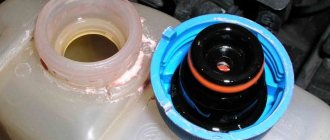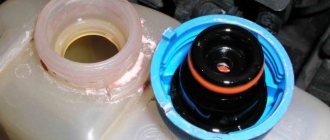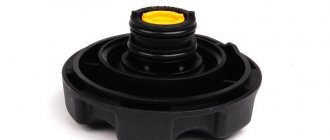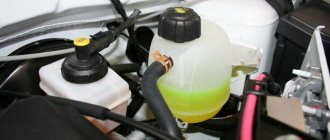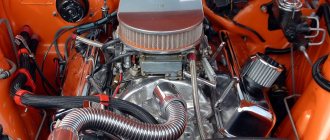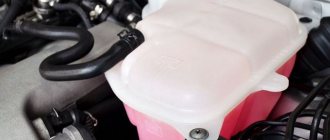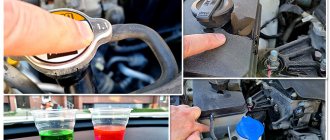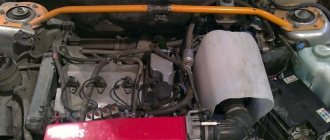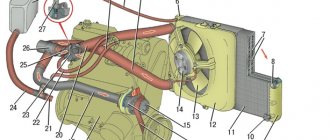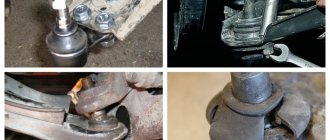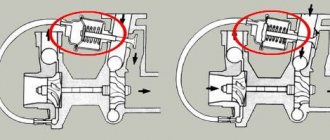The expansion tank cap is one of the simplest mechanisms in a car. In this case, its failure can lead to serious engine damage. Many people have a very obvious question: “What can break there? It's just a cover." In fact, even on the first car models, the expansion tank was equipped with a reliable lock.
When disassembling the cover, curious car owners might be surprised by the presence of springs and valves in its design. The question arises, why such difficulties when closing the container with coolant.
In this article we will try to figure this out. Let's start with the purpose, move on to the symptoms, and then find out how to check the expansion tank cap. At the end, a couple of tips from experts.
Purpose of the tank lid
In the cooling system of a running power plant, pressure gradually increases. This is caused by heating the antifreeze. This parameter requires constant adjustment. This is what the expansion tank cap is for.
Sustained high or low pressure can shift the boiling point of a liquid. Under normal conditions, water will boil at +100 °C, antifreeze and antifreeze need about 120 °C. The operating temperature of modern car engines has already come close to this threshold.
Under certain operating conditions, the coolant heats up quickly. To prevent the motor from overheating, you need to raise the boiling point of the liquid. To do this, it is enough to increase the pressure in the system.
This gave engineers the idea that in order to prevent the boiling of the coolant in the engine, during short but severe overheating, it is necessary to maintain a stable pressure within the range of 1.1-1.5 kgf/cm2. This indicator is quite sufficient, because with an even higher value, the structure will have to be equipped with more durable and reliable elements.
The expansion tank cap maintains the required pressure and, if necessary, allows air into the tank or releases excess.
Signs and possible consequences of a part malfunction
Most often, the consequence of a malfunction of the cap is boiling of the coolant, sometimes accompanied by the ejection of the coolant from the expansion tank - a common occurrence for VAZ cars. If this happens at engine operating temperatures, then most likely the plug does not hold the required pressure.
Car coolant boiling
Another reason for the same phenomenon is that due to a malfunction of the vacuum valve, air entered the ODS and formed a plug, which disrupts normal circulation, and therefore the cooling of the coolant. In winter, due to an air lock, the stove may not work well. Unpleasant consequences: loss of coolant, which has to be topped up regularly. This happens when, due to increased pressure in the SOD, liquid is “expelled” through the joints between the fittings and pipes put on them, through clamps.
Disastrous consequences:
- rupture of low-quality pipes or those that have not been changed for a long time (a picture familiar not only to VAZ owners);
- the appearance of a leak in the main or heating radiator;
- tears the thermostat housing (for Nexia it’s a common thing - into 2 parts);
- burst expansion tank.
A leak appears in the main radiator
All these signs and consequences of a malfunctioning lid are the result of increased pressure in the SOD. The latter is not uncommon for VAZ 2108, 2109 and especially 2110 cars with new-style tanks. Of course, it is obvious that the plastic of these expansion tanks leaves much to be desired, but, nevertheless, this is also due to a malfunction of the plug. So the lid, by regulating the pressure in the SOD, also protects its elements from mechanical damage.
Expansion tank cap design
The lock to the container should fit tightly, without gaps. For better connection, the lid is equipped with a rubber seal. By unscrewing it from the tank and looking at the inner surface, you can see a kind of pressure regulation sensor.
As mentioned above, there are two valves in the lid. One is designed to prevent engine overheating, the second prevents depressurization due to increased pressure.
Each of them received a name corresponding to its purpose. On VAZ cars, the high pressure valve is called a safety valve, and the low pressure valve is called a vacuum valve. Both devices are at rest until the pressure value approaches the limit value.
It is worth knowing that car owners may not always notice malfunctions in the operation of the cover valves. Visual inspection in most cases does not provide accurate information about the serviceability of devices. But a breakdown of one of the valves is fraught with serious consequences and can lead to expensive repairs.
Finalization of the new cover
Unfortunately, the quality of spare parts for domestic cars leaves much to be desired, and it is better to check the new cover on a stand. If the pressure does not hold or excess pressure is not released, you can trim the springs. To do this, the part is disassembled, the sealing rubber is pryed off and removed with a screwdriver. Then use a screwdriver to carefully remove the inner cover and remove the springs.
The large spring is trimmed by one turn, and the small spring by two turns. As a result, the exhaust valve will begin to open at a pressure of 1 atmosphere, and not 1.7 atmospheres. When checking, the inlet valve should bleed freely.
Consequences of failure of the expansion tank cap
It depends on which valve has failed. If the mechanism for releasing excess pressure breaks down, at best, some pipe will rupture and coolant will leak out. If the driver does not notice this, the engine will overheat very quickly.
In the worst case, the expansion tank may rupture and a crack will form in the radiator or interior heater. In this case, you will have to spend a lot on repairs.
If the relief valve is stuck open, the system will not have the pressure needed for proper cooling operation. The boiling point will decrease accordingly.
If the vacuum valve fails, the consequences can also be unpleasant. This will lead to an air lock, and as a result, cold air will blow from the stove when the engine is well warmed up. In cold weather this will not improve driving comfort.
How the lid works and how it works
This element has a simple structure:
- Plastic cover (shell);
- 2 springs with valve;
- Cork with holes;
- Rubber compressor.
The operating principle of the plug is also very simple: in the event of excessive heating of the cooling circuit, the regulator releases excess pressure. On the contrary, if it is low in the circuit, the regulator passes atmospheric air through itself to build up pressure. Thanks to the inlet valve, the cooling circuit is constant.
If one of the elements of the cooling circuit is leaking, air will enter the system. As a result, an air lock occurs. Where it leads? Overheating of the internal combustion engine or disruption of circulation in the entire system.
Signs of a faulty expansion tank cap
Failure of even one of the cover valves can lead to certain vehicle malfunctions and driving inconveniences. Indirect symptoms may indicate the need to check the functionality of the mechanisms. These include the following:
- Thick white smoke poured out from under the hood;
- cold air comes from the stove when the engine is warm;
- the clamps on the pipes were torn off;
- rupture of cooling system pipes;
- a crack appeared on the radiator;
- the expansion tank ruptured;
- the rubber tubes were compressed.
Smoke appears more often if the pressure in the system has exceeded the permissible value. High engine temperature and cold air from the heater indicate low engine performance.
Normal pressure in the cooling system maintains optimal operation of the engine and interior heater. A breakdown of the expansion tank cap leads to an increase in engine temperature, which leads to failure of the valves and cylinders. Only a major overhaul will help return the car to working condition.
Old motors and cork
I would like to say a few words about old engines, and why NOT the expansion tank cap. It’s just that before it was on the radiator (not on the tank) - it was nominal in nature (that is, little depended on it). Often, engines operated at atmospheric pressure, that is, the engine cooling system (ECS) did not need any pressure or sealing (no, maybe there was pressure, but not so much), and in the past they often poured water into the system, not antifreeze or antifreeze .
This happened because power units used to have thick walls (often cast iron), operated at relatively low speeds, and if during some climb (say in the mountains) your radiator began to steam, then you could just stop and wait until the car cool down and move on. The margin of safety was enormous.
How to check the functionality of the expansion tank cap
To avoid burns, the test is carried out on a completely cooled engine. In addition, the heated antifreeze in the radiator is under pressure. When the cap is unscrewed, it may splash out and cause serious burns.
There are several verification methods. Let's look at each of them:
- Visual inspection - you need to carefully inspect the cover; it should not have any signs of damage (chips, dents, etc.). If there are any, then over time a corrosion center will appear in this place and the metal will gradually deteriorate. In this case, the cover should be thoroughly cleaned and repainted. It is better to replace the damaged product with a new one.
- Checking the spring - there are springs in each cover, which belong to the safety valves. To check, you need to squeeze them with your fingers. If it offers virtually no resistance, it means it has failed. On a collapsible cover, you can replace a non-working spring. But more often the plugs are maintenance-free, so you will need to buy a new one.
- Checking the vacuum valve - you need to pull it with your fingers so that it opens. Then throw it and watch it return to the opposite position. You also need to carefully inspect the mechanism seat for traces of dirt and deposits. If they exist there are two solutions. The first thing is to try to clean it. Second, install a new cover. The choice of solution method depends on the degree of contamination of the vacuum valve.
- Checking the valve for operation - this will require special equipment. We'll talk about it a little lower.
You can use the popular method of checking the expansion tank cap. It is carried out as follows: the engine warms up well and the radiator pipe is probed with the car not turned off. If the pressure is felt, then the cap is working properly, if it is easily crushed, the valve is leaking.
There is another popular method, but experienced drivers will confirm that it does not work. Its essence is as follows: with the engine running, you need to squeeze the upper pipe with your hand. If the cap is working, then at this moment the liquid level in the expansion tank will rise. You can also remove one end of the pipe and see how the liquid flows out. But the point is that squeezing with your hands will not create the pressure required to lift the valve.
Verification Instructions
Trying to create pressure with your mouth in order to check the functionality of a potentially failed valve cover from the expansion tank is usually in vain. It is better to abandon such an idea. Otherwise, there is a risk of drinking antifreeze. And if he is also hot, then a visit to the hospital cannot be avoided.
The easiest way to check it is at a car service center. There are special pumps to create pressure. They pump the required number of atmospheres, which makes it clear whether the valve operates or not.
But many are interested in self-checking. It is also possible.
Here you need to act according to a certain algorithm.
- First, turn off the engine, let it cool for a while, then carefully unscrew the cap from the tank. Examine its condition visually. Any breaks in the seal, chips or cracks indicate the need for replacement;
- In the absence of mechanical damage, there is still no guarantee that the element is in working order. Screw the plug into place, turn on the engine at idle speed;
A fairly simple but effective way to check yourself. Its advantage is that this method is suitable for any car with a liquid engine cooling system.
There are alternative diagnostic options, but they cannot always be carried out due to the design features of the motor. If you can reach up and reach one of the thick hoses coming from the coolant reservoir. It is compressed, and before that the plug is unscrewed. Squeeze the hose, tighten the plug, and then release the tube. If it returns to its original shape, the valve performs its functions.
Despite such a modest size and external inconspicuousness, such an element of the cooling system has a huge impact on the performance of the entire engine. Therefore, you should definitely remember the reasons, signs and methods for diagnosing the condition of the valve plug on the expansion tank.
Thanks to everyone who reads us and leaves comments! Continue in the same spirit! We look forward to your feedback and pressing questions!
(
8 ratings, average: 3.88 out of 5)
Checking the lid using available tools
Checking the functionality of the valves on the cover is quite simple if you have the right tools. First you need to disconnect any pipe of the cooling system. Then, using a compressor with a pressure gauge (this will help you find out the exact release pressure), you need to supply air to the system. A hissing sound from the cap will indicate that the valve has opened.
Please note: if the valve does not bleed air, it is not recommended to quickly release the pressure, since antifreeze may splash out when opening the lid or disconnecting the pipe. Under normal conditions this is prevented by a valve.
The verification is carried out in two stages:
- First, the snout of the mechanism is lifted with your finger. It is ideal if he moves with minimal effort (virtually without resistance).
- On a cold engine, the cover is installed in its seat. Then disconnect the pipe going to the expansion tank and blow into the radiator through it. The valve is triggered by a slight excess pressure, so anyone can create it. If the cover is in working order, you will hear a characteristic hissing sound as air escapes.
Important! For this procedure, it is better to use a compressor, if you have one, otherwise you risk drinking antifreeze.
What's unusual about the coolant reservoir cap?
It would seem like an ordinary plug that closes a container with liquid, but basically all the negativity comes from the lack of liquidity of this element of the internal combustion engine. This element of the system contains 2 valve mechanisms (regulators). One relieves excess pressure, and the other, on the contrary, pumps air to increase pressure.
Related article: How to remove air from a car's cooling system
When the system heats up while the car engine is running, the valve releases excess pressure to maintain the system in working condition. As the engine cools down, the pressure in the cooling circuit drops. To prevent the pipes from starting to shrink and the system becoming inoperative, another regulator comes into play, increasing the amount of air from the atmosphere entering the system.
A very important fact associated specifically with the domestically produced cover is that this part sometimes needs to be modified by yourself in a garage or at home. From the factory, the springs have many turns, thereby forming a tight contact of the valves with the cover.
Checking the cover gasket
When checking the valves, it makes sense to immediately make sure that the top gasket of the reservoir cap is tight. Even when air whistles through the cover, this only indicates that the valve is working properly. But if the lid does not close tightly, antifreeze will gradually evaporate through the gap. As a result, its level in the system will drop.
The reverse process is also possible, when the system sucks air from the atmosphere, instead of taking antifreeze from the expansion tank. This leads to the formation of air pockets (airing).
To carry out the test, you need to disconnect the pipe coming from the expansion tank and blow air into the system through it. The pressure required is low - approximately 1.1 bar. Then close the receiver and listen. If there is no hissing, everything is fine. For greater precision, you can make a soap solution and apply it around the perimeter of the cork. If the gasket is leaking, foam will appear. In this case, the part will need to be replaced.
How to properly check the cover and fix the problem
First, inspect the part for damage. Carelessness is the main factor that can harm the entire cooling system and the engine as a whole. When purchasing a new cover, you should check it for damage, as it may be defective from the store.
If the cover has no external defects, it should be tightened and the engine started. The internal combustion engine must run to reach operating temperature. After this action, you need to carefully turn the plug counterclockwise. A hissing sound should appear. From this you can understand that the plug really works as it should.
While the engine is running, you should check the thick pipes of the cooling circuit. If there is inappropriate pressure in the system (low), then the pipes on a running engine will be depressed.
Unscrew the cap of the expansion tank and squeeze the pipe. Then close the plug and release the pipe. It should return to its original form at the everyday pressure in the cooling circuit for the power unit.
The best option for testing the system reservoir plug is a pump with a measuring indicator of the pressure level in the circuit.
Diagnostics of the element on cars of the Kalina, Priora, Gazelle models
To understand the serviceability of the cover, you need not only to check its condition, but also to carry out diagnostics using atmospheric air. Special service centers use pressure pump equipment that pumps the required number of atmospheres. It can be used to calculate the performance of the valves in the expansion tank cap.
For example, drivers of a Priora do not have a special pump, how can they check the functionality of the expansion tank cap?
This is interesting: What to do if the car door is electrocuted
Diagnostics of the quality of the plug will be less accurate, but it is still possible to identify malfunctions of the valves:
- You should first turn off the engine.
- Once the car's power unit has been standing for a while, unscrew the cap from the neck of the expansion tank.
- Inspect the part for obvious defects. Inspect the rubber seal inside the lid.
- If the plug is in good condition, return the cap and start the engine again.
- Wait until the engine reaches normal temperature.
- Take the plug in your hand and gently unscrew it until air hisses. If it appears, then the valves in the plug are ready for further operation.
- Turn off the engine and let it stand.
- Inspect the hoses adjacent to the circuit. If they are retracted, then the pressure in the system is below normal. Accordingly, the vacuum valve cannot cope with pressure regulation.
This is the basic instruction manual for AvtoVAZ models. This instruction is suitable for Kalina, Priora and Gazelle brand models.
Checking the expansion tank cap with a diagnostic device
Many who were interested in checking the cooling system plug have heard about a special diagnostic device. Such a tool is quite expensive; in 2022, I heard about an approximate amount of 15,000 rubles. Not every car owner can afford to buy such a tester. Therefore, it is only available to car services that constantly deal with such problems.
An ordinary car owner, if desired, can assemble a similar device on his own. To do this you will need the following components:
- radiator - can be taken from any old car, the condition does not matter, the main thing is that there is a whole upper part where the cover is attached;
- sandpaper;
- cold welding;
- camera nipple;
- compressor with precise pressure gauge.
The expansion tank is cut off from the radiator and all honeycombs are muffled so that air does not pass through the bottom. The same needs to be done with the side walls. Then a hole is made, the nipple from the camera is inserted into it and carefully sealed with cold welding. That's all, the device is ready.
Now you can move on to testing. The cover being tested is installed on the seat. The compressor is connected to the nipple, and air is pumped into the tank through it. By comparing the pressure gauge readings with the moment the excess pressure is released, one can judge the performance of the cover.
The main advantage of such a homemade product is the low cost of the device. The disadvantage is the complexity of manufacturing and lack of versatility. That is, the device will only fit if the diameter of the lid and the thread match. Otherwise, you will have to make another device, but from a suitable radiator.
The tester will help determine the operating pressure range of the expansion tank cap. Depending on the engine type, the readings may differ:
- Gasoline car. The safety valve opens at 83-110 kPa, for vacuum the opening pressure is -7 kPa.
- Diesel transport. For a safety valve, the value should be 108 kPa, ±15 kPa. The vacuum will open at 83 kPa.
The above values are averages, but you can use them as a guide. More accurate data on the pressure of the safety and vacuum valves can be found in the data sheet for your car, or on the manufacturers’ websites. If, during testing, the values obtained differ greatly from those indicated, then we can judge that this unit is faulty. Therefore, the cover needs to be replaced with a new one or try to be restored.
Repair of expansion tank cap
Radiator caps on modern cars are often made non-removable, so it is unlikely to be repaired. So you can remove traces of corrosion yourself and repaint the product or replace the rubber gaskets.
But if one or both valves fail, it will not be possible to disassemble them, since the body is in most cases cast. In cases where you can get to them, there is an option to try to clean them of dirt and replace the springs. Although this is a temporary measure and soon you will still have to go for a new cover.
New engines and cover
Now everything is completely different, as I already wrote (link above), the plug is now a high-pressure valve. Which runs from about 1.1 to 1.4 ATM (it all depends on the manufacturer).
How it works? It's simple. The expansion tank plug closes the cooling system, making it airtight. When the coolant heats up, according to the laws of physics it expands, and the pressure increases accordingly, and since the system is closed, here you have 1.1 - 1.4 ATM. But if the pumping continues, the lid should open! IT IS IMPORTANT.
Why is this being done, in the sense of building up pressure? Again, everything is simple - so that the coolant boils at as high temperatures as possible.
Now modern antifreezes can boil at 105 - 110 degrees Celsius, and if they are locked at 1.4 ATM, they will boil at 120 - 130 degrees!
BUT WHY SO MUCH? And here is a simple explanation - often modern engines, for example CHEVROLET, OPEL, BMW, MERCEDES, VOLKSWAGEN, etc., operate at high temperatures. Often at 110 degrees Celsius (CHEVROLET doesn't even have a temperature scale on the dashboard so as not to shock you)!
They are called “hot engines” , this is facilitated by both the design (for example, an increase in the compression ratio, an increase in revolutions, now not uncommon even at ATMO - 6 - 7000), and the installation of TURBINES. And in order not to overheat them, they need to be effectively cooled (this is not an ancient SOD), otherwise they will quickly become unusable.
Now the power units are thin-walled (they cut off metal wherever possible), TURBORATED, with an increased compression ratio. And if they overheat, the block head can move, either the block itself (perhaps even the pistons will jam), or it will “blow out” the head gasket
Well, what happens in the end. YES, the expansion tank plug is now part of this complex system. It should control both low and high pressure (so that it does not increase unnecessarily), a little more
Which is the best cover to buy?
A question that almost every car owner asks sooner or later. It’s probably worth noting right away that in terms of characteristics it should completely correspond to the one that stood before. That is, have the same diameter, thread pitch, valve sizes, as well as similar operating pressure.
Most modern cars have plugs designed to operate at 0.9-1.1 bar. But before buying a lid, you should clarify these data, as sometimes there are exceptions.
Today on sale you can find so-called “tuned” expansion tank caps. They are designed to operate at higher pressures - about 1.3 bar. This is done to further increase the boiling point of the coolant, thereby increasing engine efficiency. Such products are installed on sports cars, the power plants of which operate under heavy but short-term loads.
For an ordinary car that is used for city driving, such covers are completely unsuitable. Their installation will lead to a number of negative factors, including the following:
- Parts of the cooling system wear out - this leads to a decrease in their service life and premature failure. It’s good if after such an undertaking the pipe bursts or the clamp comes off, and you will have time to notice the leaked antifreeze. But everything can end much worse - the radiator or expansion tank may burst. And this will lead to very expensive repairs.
- Reducing the service life of antifreeze. All technical fluids have a certain operating temperature range. Exceeding it leads to a decrease in the performance characteristics of antifreeze, which negatively affects its service life. If you decide to install a tuned cover, change the coolant more often.
Hence the conclusion - do not experiment, but use the parts recommended by the manufacturer. Regarding the question of which brand is better to buy an expansion tank cap, there is no definite answer; all products have their own characteristics. The main thing is that the part is original.
Cover device
It is important to understand that there is a locking element for expansion tanks on any car that has an internal combustion engine under the hood. And it doesn’t matter whether it’s diesel, gasoline or gas-powered.
Therefore, the problem with the failure of this unit can occur on any car, including such models as:
- Lada Kalina;
- Ford Focus;
- Gazelle Next;
- Daewoo Lanos;
- Volkswagen Passat;
- Lada Priora;
- VAZ 2110;
- Renault Logan;
- Opel Astra;
- VAZ 2114;
- Chevrolet Lacetti, etc.
You already understand that the cap serves not only to prevent coolant from pouring out of the tank. This is also a pressure regulator in the system.
A valve is hidden inside the lid, usually made of plastic. It is he who takes on such responsibility. The valve is immersed inside the expansion tank and, as necessary, pumps or releases excess pressure.
Before buying a new element, if you suspect the old one is broken, you can check it. A similar type of locking mechanism should be selected.
Please note that all modern foreign cars, in the vast majority of cases, have switched to single-valve caps for expansion tanks. That is, only one valve design is physically present. It just can perform two functions at once. While on domestic cars you can still find a pair of valves. Each of them is responsible for performing a corresponding function. Whether this is good or bad is difficult to judge. But the fact remains a fact.
The lid is activated only when an excess or deficit of pressure is detected in the system. Each car has its own temperature and pressure standards for the element to operate.
I bought a new cover, but it doesn't work. What to do
Owners of VAZ 2110 and 2114 are sometimes faced with a situation where one or both valves on the purchased new expansion tank cap do not work. In this case, you can try to modify it. More often, valve malfunctions are associated with the manufacturer using too stiff springs.
To solve the problem, the first thing you need to do is disassemble the cover. This is done using a flat screwdriver and pliers. When disassembling, it is important to remember which part was placed where, as they can fly apart in different directions.
After removing the springs, they need to be trimmed a little - the large one (from the safety valve) is shortened by one turn, the small one (from the vacuum one) has two turns removed. When shortening the first part, it is important to take into account the moment the mechanism operates. The main thing here is not to overdo it and not to cut off too much. The second spring is a little easier - it should exert at least minimal pressure after closing.
Upon completion of the procedure, the components are assembled in reverse order. Now you need to check the functionality of the system and make sure that the valves operate at the right time.
Refinement of a new part - what to do if it does not function?
When it turns out that the lid stubbornly refuses to relieve excess pressure and/or is not able to restore air losses in the SOD, it can be modified. For some reason, the most complaints come from owners of VAZ, model 2109, including those who buy new plugs. It is clear that the reason for the incorrect operation of the cover valves lies in the too much rigidity of their springs.
To modify the cover, for example, for a VAZ 2109, it must first be disassembled. This must be done carefully, using pliers and a thin flat-blade screwdriver. We must try to remember where everything stood so that the springs do not fly away to God knows where. After the lid for the VAZ 2109 tank has been disassembled, it’s time for the wire cutters. They need to shorten the springs: the large one, for the safety valve, usually by 1 turn, and the small one by 2.
Shortening the plug spring
For the second, the length of the removed segment is not critical - as long as it generally supports the vacuum valve when it is closed and does not resist the external air pressure of 0.03–0.1 kgf/cm 2 . With a large spring it is more difficult - as if not to overdo it. You need to look at its rigidity and the pressure at which the safety valve opened when checking the tank cap of the VAZ 2109. After shortening the springs, we assemble the cap in the reverse order. Before use, it is advisable to check again how it works.
A few tips for maintaining a healthy system
You can avoid most problems, from minor troubles to serious damage associated with the expansion tank cap, if you follow a few rules. Professionals advise the following:
- Change the expansion tank cap at least once every 2-3 years. Aggressive coolant components attack mechanism parts and seals, gradually destroying them.
- Use only the original cover to replace a worn one. Some analogues do not allow the engine to operate at the required temperatures.
- Check and adjust the valves only on a cold engine, otherwise you risk getting burned from boiling water splashing out under pressure.
- Use tuned expansion tank caps only temporarily. Such a part will not provide optimal engine performance parameters and is therefore poorly suited for installation on a car.
In most cases, to restore the functionality of the mechanism, it is enough to simply clean the valves and rubber seals from dirt and sediment. If this procedure does not help, then it is easier to buy a new one, since modern expansion tank caps are made non-removable.
Checking the cover on the main VAZ models
Experienced owners of domestic cars have made it a rule to change the expansion tank cap every two to three years. On the one hand, such attention to detail greatly simplifies the operation of the internal combustion engine cooling system, and on the other hand, the cover costs less than 100 rubles, so absolutely every driver can afford to buy it.
And replacing the cover does not cause any difficulties. First, with the car cooled down, unscrew the cap from the tank. Then screw in the new one until it stops.
Video: diagnosing the performance of the lid
Checking the cover on the VAZ 2108/2109
The design of the “eights” and “nines” produced by AvtoVAZ allows you to check the functionality of the tank cap in one minute. The operation looks like this:
- Open the hood of a car that has cooled down after driving.
- Unscrew the cap of the expansion tank.
- Squeeze the supply hose as tightly as possible with your hand.
- At the same time, screw the lid back on.
- After this, lower the hose.
If the compression area immediately regains its original elasticity, it means that the valves on the cover are working properly. If it still cannot recover for a long time, it is recommended to replace the tank cap with a new one.
You can check the operation of the coolant reservoir cap on a VAZ 2109 with your own hands by simply squeezing the pipe with antifreeze
How to check the functionality of the cover on a VAZ 2110/2111/2112
The procedure for checking the valves on the cover is the same as for previous VAZ models. The only nuance on the VAZ of the tenth family is that when unscrewing the cap from the tank, the valve mechanism itself may fall out of the cavity of the cap. This is not an indicator of failure, but, most likely, an insecurely fixed element will not work for long.
On a VAZ of the tenth family, the expansion tank cap tends to unscrew from the neck without valves
